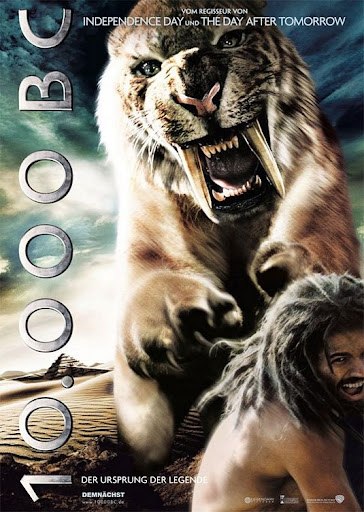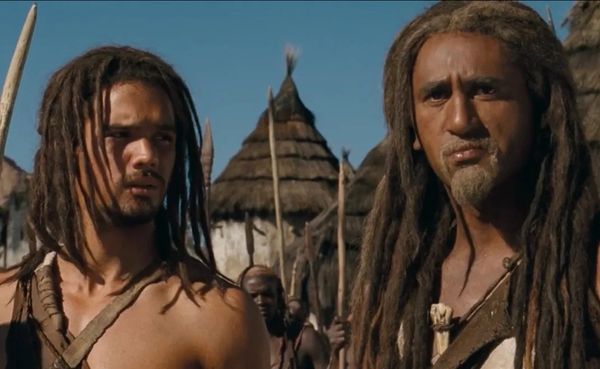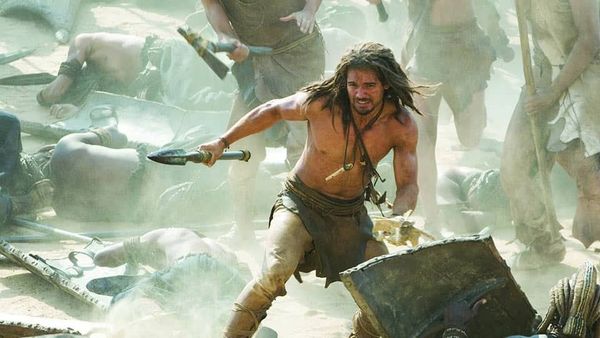🎬🎬🎬 10,000 BC (2008)

“10,000 BC” (2008) is an epic adventure film directed by Roland Emmerich. Known for his work on large-scale disaster films like “Independence Day” and “The Day After Tomorrow,” Emmerich ventures into prehistoric times with “10,000 BC,” creating a story set in a time when mammoths roamed the earth and early humans faced various challenges in their quest for survival.
The film follows the journey of a young mammoth hunter named D’Leh, played by Steven Strait. D’Leh lives in a small tribe in a remote valley and harbors feelings for Evolet, portrayed by Camilla Belle, a beautiful orphan girl with striking blue eyes. The peaceful life of the tribe is disrupted when a band of mysterious warlords on horseback raid their village, capturing several people, including Evolet. Determined to rescue her, D’Leh sets off on a perilous journey across harsh and unfamiliar terrains.
As D’Leh and his small group of companions traverse the landscape, they encounter various prehistoric creatures, including saber-toothed cats and giant birds. Along the way, they form alliances with other tribes who have also suffered at the hands of the warlords. These tribes join forces with D’Leh, recognizing him as a leader and uniting under a common cause: to free their people from enslavement.



The film’s narrative is rooted in the classic hero’s journey, with D’Leh evolving from an inexperienced young hunter into a courageous leader. His journey is marked by numerous trials and tribulations, which test his resolve and his belief in the prophecy surrounding Evolet. This prophecy foretells that she will play a crucial role in the destiny of their people.
“10,000 BC” is visually striking, with expansive landscapes and impressive special effects that bring the prehistoric world to life. The film’s production design and visual effects are some of its most notable aspects, depicting vast deserts, lush jungles, and towering mountains. The scenes featuring mammoth hunts and encounters with prehistoric predators are particularly well-executed, showcasing the film’s technical achievements.
Despite its visual appeal, “10,000 BC” received mixed reviews from critics. While some praised its ambition and the scale of its production, others criticized the film for historical inaccuracies and a lack of depth in its storytelling. The dialogue and character development were often seen as weak points, with some critics feeling that the film relied too heavily on its visual spectacle at the expense of a compelling narrative.
The film also incorporates elements of mysticism and ancient prophecy, which add a layer of mythic quality to the story. These elements, while adding to the epic scope of the film, also contribute to some of its narrative inconsistencies. The depiction of early human civilization and the blending of various historical periods and cultures are creative liberties that serve the film’s adventurous tone rather than historical accuracy.
“10,000 BC” explores themes of bravery, sacrifice, and the enduring human spirit. At its core, it is a story about a young man’s quest to save his loved one and his transformation into a leader who inspires others to fight for their freedom. The film’s climax features a dramatic confrontation between the enslaved tribes and the warlords, culminating in a battle that decides the fate of many.
In conclusion, “10,000 BC” is an ambitious epic that transports viewers to a distant and imaginative prehistoric past. Its strengths lie in its grand visuals and the adventurous spirit of its story. While it may not be historically accurate or deeply nuanced in its character portrayals, it offers an entertaining and visually immersive experience. Directed by Roland Emmerich, the film showcases his trademark style of large-scale spectacle, making “10,000 BC” a notable entry in the genre of prehistoric adventure films.













